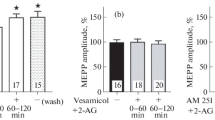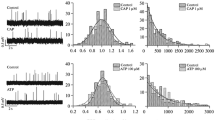Abstract
The main parasympathetic neurotransmitter acetylcholine (ACh) is released in the myocardium from the intramural postganglionic parasympathetic nerve endings. The mechanism of non-quantal ACh release has been recently demonstrated in these neurons. Non-quantal ACh release does not depend on exocytosis of ACh-containing vesicles in response to nerve impulse activity but is assumed to be mediated by the high-affinity choline uptake system. The intensity of non-quantal ACh release in the myocardium correlates with the degree of manifestation of the effects of acetylcholinesterase inhibitors inducing the accumulation of non-quantal ACh in the myocardium. The present study deals with the influence of putative modulators of non-quantal ACh release: nitric oxide (NO) and ATP, on the intensity of cholinergic effects induced by organophosphorous acetylcholinesterase inhibitor paraoxon. Intracellular registration of bioelectrical activity in isolated right atrium preparations from rats was used. Under normal conditions, paraoxon (10−7–10−5 M) induced a marked decrease in the action potential (AP) duration at a level of 50 and 90% repolarization in the working right atrial myocardium and slowed down the sinus rhythm. ATP, which is known to suppress nonquantal ACh release in the neuromuscular junction, did not induce significant reduction or augmentation of the effects of paraoxon (5 × 10−6 M). The NO donors, sodium nitroprusside (10−5 M) and SNAP (10−4 M), significantly reduced the paraoxon-induced AP shortening. Moreover, sodium nitroprusside decreased the negative chronotropic effect of paraoxon by 43.7%. On the contrary, NO synthase inhibitor L-NAME (10−4 M), which is known to suppress endogenous NO production, augmented the AP shortening caused by paraoxon. It may be deduced that NO is a universal regulator of non-quantal ACh release intensity both in the myocardium and in the neuromuscular junction.
Similar content being viewed by others
References
Arvidsson U., Riedl M., Elde R., Meister B. 1997. Vesicular acetylcholine transporter (VAChT) protein: A novel and unique marker for cholinergic neurons in the central and peripheral nervous system. J. Comp. Neurol. 378, 454–467.
Abramochkin D.V., Nurullin L.F., Borodinova A.A., Tarasova N.V., Sukhova G.S., Nikolsky E.E., Rosenshtraukh L.V. 2010. Non-quantal release of acetylcholine from parasympathetic nerve terminals in the right atrium of rats. Exp. Physiol. 95(2), 265–273.
Katz B., Miledi R. 1977. Transmitter leakage from motor nerve endings. Proc. R. Soc. Lond. B. Biol. Sci. 196(1122), 59–72.
Vyskocil F., Illes P. 1977. Non-quantal release of transmitter at mouse neuromuscular junction and its dependence on the activity of Na+,K+-ATPase. Pfluegers Arch. 370(3), 295–297.
Vyskocil F., Nikolsky E., Edwards C. 1983. An analysis of the mechanisms underlying the non-quantal release of acetylcholine at the mouse neuromuscular junction. Neuroscience. 9(2), 429–435.
Vyskocil F., Malomouzh A.I., Nikolsky E.E. 2009. Non-quantal acetylcholine release at the neuromuscular junction. Physiol. Res. 58(6), 763–784.
Abramochkin D.V., Nikol’skii E.E., Rozenshtraukh L.V. 2008. Effects of inhibitors of acetylcholinesterase on the parameters of the electric activity of rat atrial myocardium. Dokl. Biol. Sci. 420, 149–152.
Malomouzh A.I., Mukhtarov M.R., Nikolsky E.E., Vyskočil F., Lieberman E.M., Urazaev A. 2003. Glutamate regulation of non-quantal release of acetylcholine in the rat neuromuscular junction. J. Neurochem. 85, 206–213.
Malomouzh A.I., Mukhtarov M.R., Nikolsky E.E., Vyskočil F. 2007. Muscarinic M1 acetylcholine receptors regulate the non-quantal release of acetylcholine in the rat neuromuscular junction via NO-dependent mechanism. J. Neurochem. 102, 2110–2117.
Silveira C.L.P., Eldefrawi A.T., Eldefrawi M.E. 1990. Putative M2 muscarinic receptors of rat heart have high affinity for organophosphorous anticholinesterases. Toxicol. Appl. Pharmacol. 103, 474–481.
Author information
Authors and Affiliations
Corresponding author
Additional information
Original Russian Text © D.V. Abramochkin, A.A. Borodinova, E.E. Nikolsky, L.V. Rosenshtraukh, 2012, published in Biologicheskie Membrany, 2012, Vol. 29, No. 5, pp. 317–323.
The article was translated by the authors.
Rights and permissions
About this article
Cite this article
Abramochkin, D.V., Borodinova, A.A., Nikolsky, E.E. et al. Nitric oxide modulates intensity of non-quantal acetylcholine release in myocardium of the right atrium of rat. Biochem. Moscow Suppl. Ser. A 6, 288–293 (2012). https://doi.org/10.1134/S1990747812040022
Received:
Published:
Issue Date:
DOI: https://doi.org/10.1134/S1990747812040022




